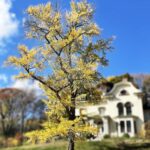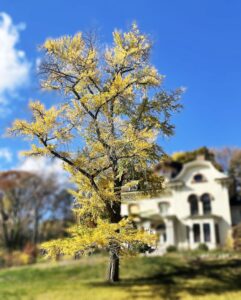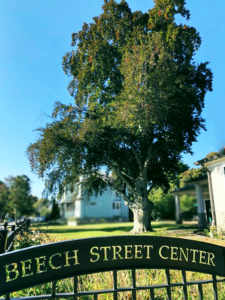
By Fred Bouchard
Tawny branches reach skyward around its diminished crown like a monk’s tonsure. Strafed by ligneous crows’ feet and tagged with a bowie knife by ”Oliver” (World War veteran?), its trunk is knobbled with rusts and growths. Golden wreaths of lichen encrust its bolus. The copper beech standing sentinel opposite the stone rail trestle in Belmont Center bears silent witness to a century and a half of local history.
It was a mere sapling, perhaps part of the project when H. H. Richardson’s firm rebuilt the Unitarian Universalist Church in 1890. Wellington Station marked the adjacent train stop in 1900. The original B&M Railroad station (long the Elks Club) and the Cyclopean underpass date from 1906.
Town tree wardens have spent time and effort treating this showcase giant’s ailments over the decades. Each of its twice-annual sprayings against that shiny scarab, the emerald ash borer, costs $200. The giant black ash tree in the Grove Street playground, another signature meeting spot, has received similar injections.
Other majestic copper beeches attest to the species’ century-plus longevity: the goliath at Somerset and Wellington; 75 Fletcher Road; 4 Pine Street and Trapelo Road; several along Common and Pleasant Streets (notably at the Belmont Women’s Club). Yet some copper beeches—and many other hoary but redoubtable aged trees in town—have been less fortunate.
Will our graybeards survive the century?
Many of our venerable trees now succumb to the whims of worried, defensive, or callous homeowners. Within the past two years, I’ve noted with dismay that several sturdy trees in my immediate (half a block) neighborhood had been cut down for reasons other than poor health: insurance denial, acorn and leaf litter, revenge for a fallen limb that dents a car or shatters a fence, property line impingement, impeded sight lines, sheer cussedness, and yes, even unsightly old age.
Meanwhile the naturalists, aesthetes, and conservationists among us trumpet that trees are vital to our very existence. (See “Urban Trees Improve Everyone’s Lives,” BCF Newsletter, November 2021.)
You can scientifically quantify one tree’s contribution to our health and welfare with online metrics that calculate its sequestration of carbon emissions (itreetools.org) and assess the collective benefits of shade and canopy afforded by urban parklands (treeequityscore.org). Or you can simply take a stroll, breathe deep, and eyeball appreciatively these wondrous branchy beings that share and bedazzle our biosphere.
Sure, trees are good for everyone in every way. Except, that is when they become nuisances: contributing leaf litter, crunchy acorns, stinky fruit, fallen limbs, or offering unwanted shade, blocking solar panel exposure, or obstructing new building projects.
I chanced to peek into a neighbor’s yard when, after summer travels, I noticed a grounds crew parked out front. I was astonished to see that the 65-foot copper beech that had graced and shaded their spacious yard (since long before it was a yard) had been obliterated: cut down, logged, and carted off, its stump ground flat. In its place a stone patio.
I asked what had precipitated such a shocking change. “Oh,” they deflected dismissively with a vague litany of common complaints, “Squirrels, fall leaves, too dark in the summer..” Other neighbors have varied experiences. One cut down two mature oaks in fear after a large storm-blown limb seriously damaged his car. By contrast, a tree-loving neighbor opted to plant a sidewalk red maple, which, even as a sapling, showed famously, enduringly russet in this past banner autumn.
Are we doing all we can to accommodate these stolid, silent, defenseless elderly citizens that bring quiet beauty into our lives and do so much to balance our fragile biosphere? I freely admit being an unabashed tree-hugger: a 40-year birdwatcher, woods-hiker, butterfly admirer, gardener, and nature buff. Whenever chainsaw-wielding tree surgeons clatter up in their cherry picker trucks, I grimace, hastily pack a bag, and set out for the day. It hurts my ears and breaks my heart to watch these gentle giants come crashing down.
Town of Trees?
Belmont is famed as a Town of Homes, and is at work to merit, as Weston has done, the moniker “Town of Trees,” designated by the National Arbor Day Foundation. A town-wide tree plan has ramped up again since COVID-19-era setbacks of canceled plantings and under-supplied nurseries. The Belmont Department of Public Works (DPW) has resumed plans for a 120% replacement of plantings over cut-downs. Belmont’s tree census—the first in decades—is now underway thanks to a $55,000 capital budget award from Town Meeting. An additional $25,000 was granted to plant trees, which will contribute a green investment towards a century-long legacy.
“It’s the first budget for trees since the retirement of Tom Walsh, town tree warden,” said Jay Marcotte, who has taken over as tree warden. “Belmont has been woefully underfunded. The effects of the summer drought are noticeable, as some trees defoliate without changing color and show other signs of stress. The DPW is watching them for potential removal or pruning by spring. The DPW and Belmont Light have shared responsibilities for pruning dead limbs and those encroaching on power lines. Storm crews are called in as needed.”
Budding Tree Program
A citizen-funded Memorial Tree Program is also taking off, where residents contribute $500 for a tree to be planted on (or adjacent to) their property. Over 20 trees are slated to be planted this fall and another 20 or more next spring. Find out more at www.belmont-ma.gov/dpw-parks-cemetery-division/pages/memorial-tree-program.
Marcotte continued: “We work with participants and vendors to plant the right way. We choose reliable trees for urban settings: katsura, zelkova, red maple, London plane [aka sycamore], basswood, gingko, and others. We select the right tree (by size or species) for the right location and conditions. Overhead wires, for example, are an issue; we’d choose one of the smaller varietals there.
“It’s also important to avoid lifting sidewalks. Zelkovas [aka Japanese elms] fit nicely in some narrow spots, as they root deeply, unlike the maple’s broad root system.” They thrive in open spaces and grow prodigiously with a pretty burgundy oval leaf. Several saplings that adorn the triangular parklet in front of the M+T Bank on Leonard Street have become favored shade spots for the after-school set. My neighbors happily planted a zelkova sapling in the middle of their grassy yard and have joyfully watched the slender trunk shoot up almost two feet per year.
Favorites to visit
Your reporter chooses the 90-foot tulip tree towering over 24 Clover Street. Tree warden emeritus Tom Walsh votes for sugar maple, admitting that you have to pick the right spot: “You just can’t plant a sugar maple by the side of the road. Sidewalk trees must be tolerant of soil compaction and road salt and require watering.” Choose your own favorite from the town website’s Notable Tree List at bit.ly/BCF-123-Trees.
Tree Enemies
National arboreal data indicate that one in six tree species in the lower 48 states is at risk of extinction due to predations of rapacious insects, invasive fauna, and climate change.
Marcotte states that Belmont “has no local data as yet on species at special risk. None are endangered.” Nevertheless, many trees are at some risk from natural pests. Here is the DPW’s wanted list of harmful bugs. If you spot these afflicting critters, contact the DPW. At present, no official town-wide or home treatment is recommended.
Winter moths feed on and defoliate deciduous trees and shrubs, including oak, apple, elm, maple, ash, crab apple, cherry, and blueberry.
Woolly adelgids, introduced from Europe a century ago, have colonized widely in New England and have devastated Eastern hemlocks. .
Emerald ash borers are iridescent Asian jewel beetles that have spread widely in Middlesex and 10 other counties. A national quarantine zone limits the movement of all ash species plant materials (hardwood, firewood, green wood, nursery stock) to curtail its widespread predation. The DPW sprays notable keynote individual trees.
Asian longhorn beetles were confined to Worcester and Suffolk Counties through 2018. This scary-looking striped beetle now assaults ash trees in town. They can fly a mile a day and can attack all foliating trees.
Spotted lanternflies are gaudy red Asian planthopper pests. They have been creeping northward from Pennsylvania and have now been spotted in Middlesex County.
What to do and not do
What can readers do? Water your shrubs and trees in dry times. Raise awareness. Check for signs of insect tell-tales and call the DPW if you notice anything unusual about leaf-drop and other signs of stress: chewed, spotted, or limp foliage; holes in the bark; or shedding bark.
Adopt a tree in your neighborhood. Especially in drought years, trees need a little wet love. The Belmont Garden Club has supplied young and vulnerable trees with Treegator bags for over 150 trees around town; arrange to adopt one and water it appropriately.
Join an organization that celebrates, plants, and protects trees, such as the Arbor Day Foundation (arborday.org) or Speak For The Trees (treeboston.org).
Respect our elder, sentient neighbor beings. Do not rush to maim (haphazardly prune) or destroy (contract to poison or cut down) an “offending” tree on your property. Instead, discuss with abutting neighbors, an arborist, or contact the DPW.
Fred Bouchard is a Belmont resident and a member of the Belmont Citizens Forum Newsletter Committee.




Sorry, the comment form is closed at this time.